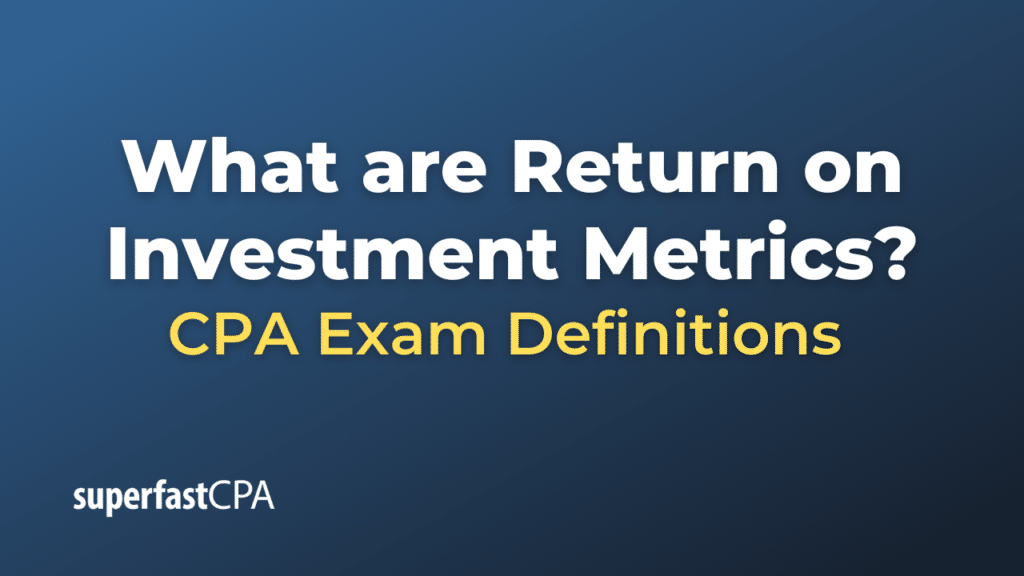Return on Investment Metrics
Return on Investment (ROI) metrics are a set of financial measurements used by businesses and investors to evaluate the performance of an investment or to compare the performance of several different investments. ROI metrics aim to quantify the financial returns of an investment in relation to its cost.
Here are some commonly used ROI metrics:
- Return on Investment (ROI):
This is the basic metric discussed earlier. It calculates the percentage return on a particular investment relative to its cost.
ROI = Net Profit from the Investment − Cost of the Investment / Cost of the Investment × 100% - Return on Equity (ROE):
This measures the profitability of a company by comparing its net income to shareholders’ equity. It helps investors understand how effectively company management is generating earnings from their equity capital.
ROE = Net Income / Shareholders’ Equity - Return on Assets (ROA):
This metric provides insights into how effectively a company is using its assets to generate profit.
ROA = Net Income / Total Assets - Return on Invested Capital (ROIC):
A measure that indicates how well a company is using its money to generate returns.
ROIC = Net Operating Profit After Taxes (NOPAT) /Total Invested Capital - Return on Sales (ROS) or Operating Profit Margin:
This metric examines the operational efficiency of a business by comparing operating income (or EBIT) to total sales.
ROS = Operating Income (EBIT) / Total Sales - Payback Period:
This is the amount of time it takes for an investment to generate a return equal to the original investment cost. While not a percentage-based ROI metric, it is often used to determine the desirability of an investment or project. - Discounted Cash Flow (DCF):
This metric estimates the value of an investment based on its expected future cash flows. By accounting for the time value of money, DCF can provide a net present value (NPV) of an investment, helping investors understand its potential future worth in today’s terms. - Internal Rate of Return (IRR):
This is the discount rate that makes the NPV of all cash flows from a particular investment equal to zero. It is useful for understanding the expected annual return of an investment or project. - Modified Internal Rate of Return (MIRR):
A modification of the IRR, MIRR accounts for the realities of different reinvestment rates for positive and negative cash flows and provides a more realistic estimate of an investment’s profitability. - Cash on Cash Return:
Often used in real estate investing, this metric measures the annual return on an investment relative to the cash invested, excluding aspects like amortization or appreciation.
Cash on Cash Return = Annual Cash Flow / Total Cash Invested
Each of these ROI metrics offers a unique perspective on the profitability or attractiveness of an investment. The appropriate metric (or combination of metrics) to use depends on the specific context, the nature of the investment, and the information one seeks to extract.
Example of Return on Investment Metrics
Let’s illustrate using some of the ROI metrics in a fictional scenario involving a company called XYZ Corp.
XYZ Corp Financials for the Year:
- Net Income: $500,000
- Shareholders’ Equity: $2,500,000
- Total Assets: $4,000,000
- Sales (Revenue): $5,000,000
- Operating Income (EBIT): $700,000
- Total Invested Capital (Equity + Interest-bearing Debt): $3,000,000
Calculations:
- Return on Equity (ROE):
ROE = Net Income / Shareholders’ Equity
ROE = 500,000 / 2,500,000
ROE = 20% - Return on Assets (ROA):
ROA = Net Income / Total Assets
ROA = 500,000 / 4,000,000
ROA = 12.5% - Return on Sales (ROS):
ROS = Operating Income (EBIT) / Sales
ROS = 700,000 / 5,000,000
ROS = 14% - Return on Invested Capital (ROIC):
ROIC = Net Income / Total Invested Capital
(assuming for simplicity that net income can be used as a proxy for NOPAT in this instance)
ROIC = 500,000 / 3,000,000
ROIC = 16.67%
Analysis:
- ROE of 20%: For every dollar of shareholders’ equity, XYZ Corp generated a profit of 20 cents.
- ROA of 12.5%: This means XYZ Corp generated 12.5 cents of profit for every dollar of assets they own. A higher ROA indicates more efficient use of assets to generate profit.
- ROS of 14%: This indicates that for every dollar in sales, the company generated an operating profit of 14 cents before interest and taxes. It’s a measure of operational efficiency.
- ROIC of 16.67% : This demonstrates that for every dollar of total capital invested in the business (both equity and debt), the company generated a return of 16.67 cents.
By analyzing these metrics, an investor or analyst can better understand the performance and efficiency of XYZ Corp in terms of how well it generates profit from its equity, assets, sales, and total invested capital.
This fictional scenario provides a simplified view of ROI metrics. In real-world applications, other factors, like industry benchmarks, historical performance, and external market conditions, would also play a crucial role in the analysis.













